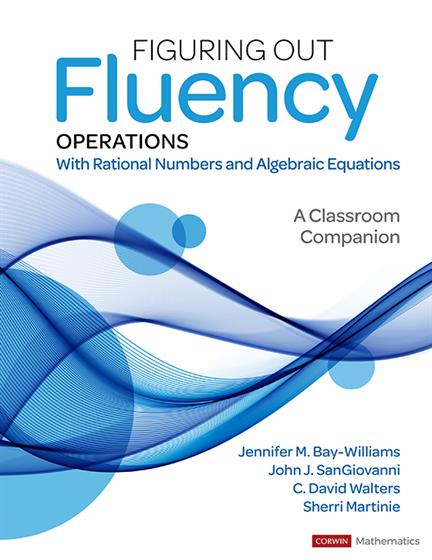Hands-on, Practical Guidance for Educators
From math,
literacy, science, equity, multilingual learners, and SEL, to assessment, school counseling,
and education leadership, our books are research-based and authored by experts
on topics most relevant to what educators are facing today.

Figuring Out Fluency – Operations With Rational Numbers and Algebraic Equations
Give each and every student the knowledge and power to become skilled and confident mathematical thinkers and doers.
- Grade Level: PreK-12
- ISBN: 9781071825181
- Published By: Corwin
- Series: Corwin Mathematics Series
- Year: 2022
- Page Count: 232
- Publication date: August 15, 2022
Review Copies
Description
“This book is awesome! What stood out to me was the deep understanding I was able to have about what fluency actually means. Too often the message has been fluency and accuracy, especially at the middle school level. By providing teachers with tools for building fluency with integers, expressions, and algebra, this book shifts that message to also focus on flexibility and strategy selection.”
Lindsey Henderson
Secondary Mathematics Specialist, Utah State Board of Education
Salt Lake City, UT
Because fluency practice is not a worksheet.
Fluency in mathematics is more than adeptly using basic facts or implementing algorithms. It is not about speed or recall. Real fluency is about choosing strategies that are efficient, flexible, lead to accurate solutions, and are appropriate for the given situation. Developing fluency is also a matter of equity and access for all learners.
The landmark book Figuring Out Fluency in Mathematics Teaching and Learning offered educators the inspiration to develop a deeper understanding of procedural fluency, along with a plethora of pragmatic tools for shifting classrooms toward a fluency approach. Now, teachers have the chance to apply that inspiration through explicit instruction and practice every day with the classroom companion Figuring Out Fluency—Operations With Rational Numbers and Algebraic Equations. With this book, teachers can
- Dive deeper into the Significant Strategies for fluency explained in the anchor book as they apply to rational number operations
- Explore how these strategies can be applied for proportional reasoning, solving equations for unknowns, and solving systems of linear equations
- Access over 100 classroom-ready activities, including worked examples, routines, and games.
- Find activities to explicitly teach students how to use and choose strategies to operate on rational numbers and solve algebraic equations
- Download all of the needed support tools, game boards, and other resources from the companion website for immediate implementation
Give each and every student the knowledge and power to become skilled and confident mathematical thinkers and doers.
Author(s)

Jennifer M. Bay-Williams

John J. SanGiovanni
John J. SanGiovanni is a mathematics coordinator in Howard County, Maryland. There, he leads mathematics curriculum development, digital learning, assessment, and professional development. John is passionate about growing new mathematics leaders in the district and through McDaniel College. In addition to the Figuring Out Fluency series, some of his many Corwin books include Daily Routines to Jump-Start Problem Solving, Grades K–8; Answers to Your Biggest Questions About Teaching Elementary Math; the Daily Routines to Jump-Start Math series; and Productive Math Struggle: A 6-Point Action Plan for Fostering Perseverance. John is a national mathematics curriculum and professional learning consultant who also speaks frequently at national conferences and institutes. He is active in state and national professional organizations, recently serving on the board of directors for the National Council of Teachers of Mathematics (NCTM) and on the board of directors for NCSM.

Sherri Martinie
Table of Contents
Part 1: Figuring Out Fluency: Key Ideas
Part 2: Strategy Modules
Module 1: reasoning Strategies for Addition
Module 2: Reasoning Strategies for Subtraction
Module 3: Reasoning Strategies for Multiplication
Module 4: Reasoning Strategies for Division
Module 5: Reasoning Strategies for Ratios and Proportions
Module 6: Strategies for Solving Equations for an Unknown
Module 7: Strategies for Solving Systems of Linear Equations
Part 3: Putting it All Together: Developing Fluency
Reviews
This book places a premium on mathematical thinking. The authors make the compelling case using myriad examples that fluency requires reasoning and relies on conceptual understanding. If you want your students to confidently choose and flexibly use a range of strategies when working with rational numbers and algebraic equations, dig into the treasure trove of engaging activities in this book!Grace Kelemanik
Sixth grade is a challenging time for fluency development—some students are still working on basic fact fluency, while others are starting to engage in a more sophisticated way of algebraic thinking. This book is an excellent resource for scaffolding middle school students on a personal level wherever they may be on the fluency continuum!Kiersten Campbell
Figuring Out Fluency is a necessary resource for every middle school mathematics educator seeking to grow their knowledge base, learn effective teaching strategies, and gain access to teaching activities they can immediately implement.Kristopher J. Childs
Equity, and Social Justice Officer—Open Up Resources
This book is exactly what the mathematics world needs. Even as a veteran teacher, I need to be reminded that students need explicit strategy instruction. Students need to see that there are efficient ways to solve problems and the standard algorithm isn’t always the best. This companion book is overflowing with ideas for the classroom teacher to improve mathematical fluency!Elizabeth Uden
Despite striving for students to develop fluency with number and operations, inconsistent definitions of what it means to be fluent and a lack of understanding to implement effective fluency-building practices can leave you feeling defeated. Enter the action-oriented Figuring Out Fluency book that clarifies what it means to be fluent with number and operations while providing content specific examples that can be implemented in your classroom to begin seeing the fruit of your professional learning efforts.Kyle Pearce
This is a book you keep on your teacher-desk! It’s full of classroom activities for your classroom while at the same time, it teaches you how to build your own activities so you can build mathematical fluency for your students.Jon Orr
Lambton Kent District School Board
This book is like a full-course meal. Each course complements the other, from the amuse-bouche to the main course where each module, from operations of whole numbers to solving systems, leaves the reader satisfied with figuring out fluency. Lastly, as sweet as the dessert, developing fluency puts it all together. This is the most practical math book for secondary instruction of this time.Valentin Sotomayor
Seminole County Public Schools
When most educators hear “fluency,” they immediately think of elementary school. The authors do a masterful job of pushing us to think of fluency at the middle grades as well and provide concrete examples of what it looks like. The activities are ready to implement immediately to bring to life the key ideas around fluency for rational numbers and algebraic equations.Kevin J. Dykema
This book is the instruction tool I have been looking for with essential insights to effective mathematical teaching without unnecessary details. Filled with explicit ideas on how to build fluency, the book merges conceptual and procedural learning goals perfectly. A must-have tool for both educators and students looking for a deeper understanding of mathematics.Kirk Redford
efficient and flexible but also lead to accurate solutions and are appropriate for the given situation. The fun and engaging activities, examples, and games all stress that fluency is also a matter of equity and access for all learners.
This brilliantly crafted book stresses the importance of teaching mathematical fluency as equipping learners with multiple strategies that are not onlyKanita K DuCloux
efficient and flexible but also lead to accurate solutions and are appropriate for the given situation. The fun and engaging activities, examples, and games all stress that fluency is also a matter of equity and access for all learners.
Western Kentucky University
This book is awesome! What stood out to me was the deep understanding I gained about what fluency actually means. Too often the message has been to focus on fluency and accuracy, especially at the middle school level. By providing teachers with tools for building fluency with integers, expressions, and algebra, this book shifts that message to also focus on flexibility and strategy selection.Lindsey Henderson
Utah State Board of Education
Building fluency certainly does not end in elementary! This book guides teachers seeking to help students make essential connections between first, rational number operations and familiar whole-number strategies, and second, number sense and solving abstract algebraic equations. What a great resource for novice and experienced teachers to explore together!Tiffany Spralding
Figuring Out Fluency succeeds in delivering a true understanding of mathematical fluency. It encourages a shift from basic memorization of facts to developing and mastering one’s math psyche and revelatory understandingSteven Geiger
Volusia County Schools
Operations With Rational Numbers and Algebraic Equations is an excellent addition to the Figuring Out Fluency series. This book brings to light how fluency is carried through to the higher grades—a must for math teachers. Bay-Williams and SanGiovanni highlight how fluency beyond whole numbers is possible and should be promoted in all of our students.Pam Harris
Texas State University
This book paints a vibrant picture of the life fluency can live beyond the confines of basic math facts and memory exercises starting with early grade areas of fluency, through rational reasoning, and stretching far into the heart of algebraic reasoning.Rachel Bachman
Weber State University
The resource that every middle school educator needs whether you are new or experienced in teaching operations with rational numbers and algebraic equations! The authors walk you through how procedural fluency is achieved by incorporating research-based strategies. There are routines, games, and activities for supporting instruction in the classroom to empower your students as mathematicians!Micaela Wang
This latest edition to the Figuring Out Fluency series is written specifically to address the needs of middle school learners. Finally, middle school math educators have a playbook of research-aligned strategies to support fluency. The focus on the importance of reasonableness, the three moves to support reasonableness, and 100+ classroom-ready activities are a welcome addition to any classroom!Latrenda Knighten
A fantastic resource! For years, I have pulled from multiple sources to help teachers develop a comprehensive view of teaching middle grades mathematics. Now it is all in one place! Not only does Figuring Out Fluency elaborate on the trajectory of mathematical content, but it also offers a variety of activities, games, and routines to help students reason, strategize, and develop “real” fluency.Rodrigo Gutiérrez
University of Arizona CRR Co-Director
Review Copies
Related Resources
-
Helping Students Choose a Strategy
[Lessons and Strategies] -
Quotient Connect Game
[Lessons and Strategies] -
Using Basic Transformations to Start Solving Equations
[Lessons and Strategies] -
Worked Examples For Ratios and Proportions
[Lessons and Strategies]

